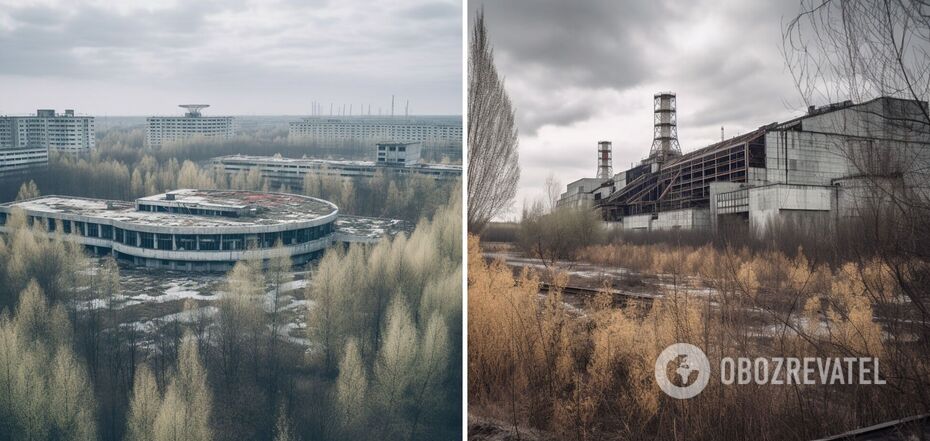Life
Anniversary of the Chornobyl disaster: history and number of victims of the tragedy that shook the whole world
Every year, on April 26, Ukraine and the world commemorate the victims of the Chornobyl nuclear disaster. This year marks the 37th anniversary of the largest nuclear accident in history.
OBOZREVATEL tells in detail about the tragedy. As well as about its victims and the future of the plant.
What happened at the Chornobyl nuclear power plant on April 26, 1986
On the night of April 26, 1986, a scheduled shutdown of Unit 4 reactor took place at the Chornobyl nuclear power plant. The check of electrical equipment was supposed to last 20 seconds. But almost immediately after it began, the power dropped well below the planned level, and the reactor core was poisoned by the xenon-135 isotope. This disrupted the normal course of the experiment, and as a result, two thermal explosions occurred around 01:23:47 am Kyiv time, with a difference of only a few seconds.
The fourth power unit of the Chornobyl nuclear power plant suffered significant damage, the reactor was completely destroyed and a fire broke out. A huge amount of radioactive substances was released into the atmosphere. Subsequently, the emission cloud spread to large areas of Ukraine, Belarus (about 60% of the contamination), Russia, covered most of Europe and even reached the eastern part of the United States.
The fire at the Chornobyl nuclear power plant lasted for many days. The first firefighters who arrived to extinguish it were unaware of the radiation hazard and fell ill with radiation sickness after that shift.
The Soviet authorities kept the fact of the disaster quiet until the very end, but on April 27, they were forced to start evacuating civilians from the city of Prypiat and nearby settlements. People were told that they were leaving their homes for only three days. As a result, about 300,000 people were evacuated, most of whom never returned home, as a 30-kilometre exclusion zone was subsequently created around the power plant.
Further events at the Chornobyl nuclear power plant
In 1986, a concrete sarcophagus was built over the destroyed power unit, after which the Chornobyl NPP continued to operate and generate electricity. However, on February 17, 1990, the Verkhovna Rada of the Ukrainian SSR decided to decommission the plant and set the timeline for all necessary processes. The final shutdown of ChNPP took place at a special ceremony on December 15, 2000. Since then, the plant has been operating as a research facility, and the impact of radiation on the environment has been studied in the exclusion zone.
At the same time, it was necessary to address the issue of safely covering the fourth power unit, as the protective structure erected after the accident was temporary. On September 17, 2007, it became known that an arched steel confinement would be built over the old shelter. The project was an international one, with construction starting in 2012 and ending on November 29, 2016. The arch was slid over the destroyed power unit and within a year, the radiation level near it decreased by 10 times. The confinement was fully commissioned on July 10, 2019. According to the project, its service life is 100 years.
Chornobyl NPP was discussed again in early 2022, when Russia launched a full-scale military invasion of Ukraine. During an attempt to break through to Kyiv, the occupiers seized the ChNPP. It happened on the very first day of the war - February 24. The Russians repeatedly turned off the plant's external power supply, which was necessary for the safe storage of spent fuel, threatening the world with a new nuclear disaster. The invaders also dug trenches in the contaminated soil, bringing buried radioactive substances to the surface. In doing so, they were exposed to radiation themselves.
ChNPP was liberated from the occupiers on March 31, 2022. On April 16, stable power supply to the spent fuel storage facilities was restored.
Today, the Chornobyl Radiation and Ecological Biosphere Reserve operates in the 30-kilometre zone of the affected area. It was established in 2016. Today, wildlife populations, including wolves, bears, and foxes, are gradually being restored there. Thus, a fairly large population of rare Przewalski horses has been restored here.
Victims of the Chornobyl accident
It is quite difficult to accurately estimate the number of victims of the Chornobyl accident, as the consequences for human health often manifested themselves years later. However, rough estimates suggest that more than 1.7 million people were affected to varying degrees. More than 520,000 people were recognised as liquidators of the accident.
The accident caused a surge in cancer in contaminated areas. The International Health Organisation also noted that many health problems among the liquidators and victims were caused by the stress of the disaster. These include cardiovascular diseases, metabolic disorders, nervous diseases and other problems not directly related to radiation exposure.
Commemorating the victims of the Chornobyl disaster
Every year, on April 26, Ukraine celebrates the Day of Remembrance of Victims of Radiation Accidents and Disasters, as well as the Day of Remembrance of the Chornobyl Accident. On this date, it is customary to remember all those who died and suffered from the accident. It is also a day to honour all the liquidators - firefighters, rescuers, doctors and other professionals who have fought and continue to fight the consequences of the 1986 accident.
At the international level, the UN General Assembly proclaimed April 26 as the International Day of Remembrance for the Chornobyl Disaster. The decision was made in 2016. On this day, commemorative and educational events dedicated to the events in Chornobyl are held around the world.
Earlier, OBOZREVATEL told you about the special genes that dogs living in the Chornobyl exclusion zone have.
Subscribe to OBOZREVATEL's Telegram and Viber channels to keep up with the latest news.



























